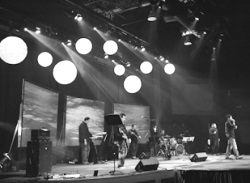Not too long ago, in a church not that far away, the battle had begun.
It started off innocently enough. The bass player and drummer had to share a monitor because there were not enough to go around (budget constraints, you know).
The first request was for a little more bass in the monitors. That was followed by a request for more kick and snare, then a little more bass.
Now the drummer needed kick, snare and toms turned up. But the bass player couldn’t hear anymore, so he needed more.
By now the level of those two monitors had reached 86 dB at front of house. The arms race had started; the Monitor Wars had begun.
Sound familiar? It happened in my church every week until about six months ago. Frustrated at using the house speakers to cover up the stage sound (and just barely at that), I began looking for a better way.
Having spent many a summer shooting video of Christian music festivals, I was aware that most of the touring acts had gone to in-ear monitors, mainly the wireless variety. I greatly appreciated the lower volume on stage (I could actually talk to my grip…), but I also knew that without a separate monitor desk and operator (neither of which we had nor could afford), wireless in-ears would not help us.
I remembered an instant message conversation I had with a friend some years back about a personal monitor technology that used Cat-5e cable to send 16 channels of audio to the stage and was distributed to each musician in a way that allowed them to control their own mix.
Some quick Internet research led me to Aviom and the Personal Mixing II system.
The concept is simple enough; take 16 channels, direct outs, aux sends, group outs, whatever, and patch them into the input module. Those 16 channels get sent via a single wire to the stage where it is daisy-chained to each mixer.
Every musician gets full control over his or her mix without affecting any other. The system is wired, but since our guitar players rarely stage dive, this is not a limitation.
The benefits are many. The most noticeable is that stage volume is reduced significantly. No longer is the house mix merely a mask for the stage monitors.
Our FOH engineers can actually create a mix that sounds great, and keep the volume 6-8 dB lower (which makes our more senior worshipers very happy!). It is now possible to turn the electronic drums down in the house, and have them go down – finally the benefit of electronic drums realized!
Another bonus is the generation of additional monitor mixes. Whereas we used to have four, we now have nine – four aux sends from the board for vocalists and the choir, and five personal mixes for the band.
Not only do vocalists require lower levels, but we now have enough that the worship leader doesn’t have to share with the harmony singers, and we have enough left over for the brass section and choir. No more sharing. This makes everyone happy, including the engineers who have far more control to please everyone on stage.
I have to admit to a bit of fear and trembling when I was about to roll out the system. I knew it was a great solution, but would the musicians agree? Would the system be user friendly; would it sound good enough; would they revolt and refuse to use it?
Thankfully my fear was unfounded. I made some good decisions (in hindsight) that really helped the adoption go smoothly. First, I talked it up for months beforehand. I knew the musicians (and the sound guys for that matter) were frustrated with the current state.
Though I bought the equipment in the summer, I didn’t plug anything in until mid-fall. I wanted time to play with it, show it off and tell everyone how great it would be.





















